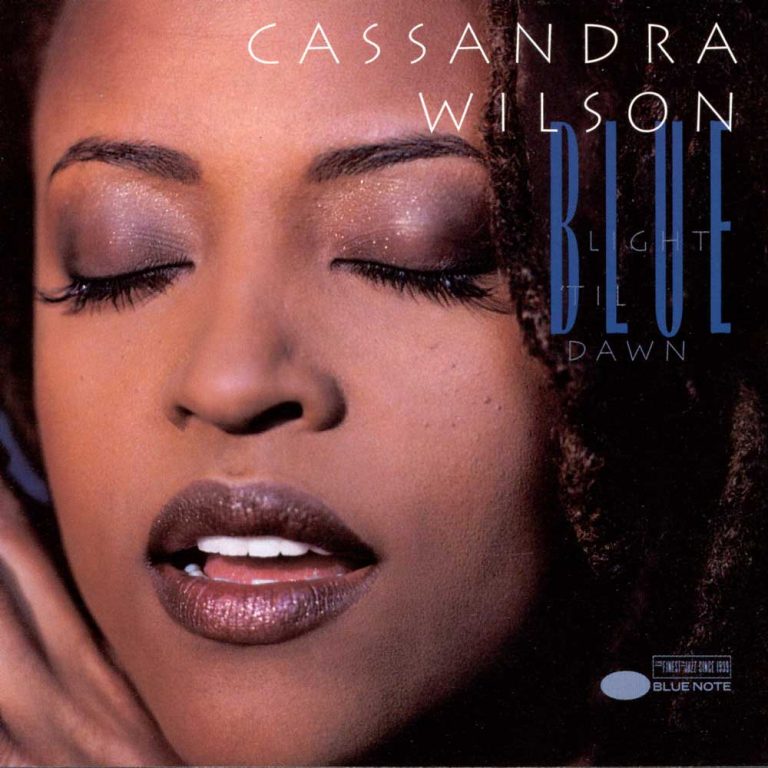As part of The Guardian’s “A History of Jazz in 50 Key Moments” in 2011, critic John Lewis placed the release of Cassandra Wilson’s 1993 album “Blue Light ‘til Dawn” alongside such seminal events as Louis Armstrong buying a cornet and Billie Holliday first performing “Strange Fruit”.
In his appreciation of the album Lewis wrote: “When Cassandra Wilson signed to Blue Note in 1993 she had been struggling to find a suitable vehicle for her gorgeous contralto…Ever since then, Wilson’s pastoral jazz has dug deep into the terrifyingly gothic spirit of Robert Johnson while cleverly ignoring the blues clichés.”

CASSANDRA WILSON Blue Light 'Til Dawn
Available to purchase from our US store.Cassandra Wilson was raised in Mississippi in the cradle of the blues where legend has it that Robert Johnson sold his soul to the devil at the crossroads of Highways 61 and 49 in Clarksdale. But it was in the urban cultural melting pot of the New York scene of the 1980s that she made her name as a jazz vocalist.
There she met alto saxophonist Steve Coleman and became a founding member of his sprawling M-Base Collective out of Brooklyn. Coleman has explained M-Base (Macro – Basic Array of Structured Extemporizations) as a means of expressing experiences “through music that uses improvisation and structure as two of its main ingredients’ and a thrust for “conceptual growth as opposed to technical growth.”
It was in this liberating and collective space that Wilson pushed the boundaries of vocal jazz on a string of seminal collaborative M-Base albums in the mid to late 1980s and early ‘90s – from Steve Coleman and the Five Elements “On The Edge of Tomorrow” from 1986 to M-Base Collective’s “Anatomy of a Groove” in 1992.

M-Base’s complex harmonics did not lend themselves naturally to a jazz vocal, but Wilson rode the grooves effortlessly, her luxuriously wide vibrato and bending of pitches proving the perfect match to Coleman and his associates edgy “street jazz.”
Beginning with “Point of View ” from 1985 she recorded eight albums under her own name for the Munich label, JMT, home to Steve Coleman and The Five Elements and other M-Base artists like saxophonist Greg Osby, cornetist Graham Haynes and pianist Gerri Allen. At the same she joined the avant-garde trio New Air alongside AACM alto saxophonist Henry Threadgill appearing on the 1986 album for Black Saint “Air Show No. 1.”
Despite this immersion in the avant-garde, Cassandra Wilson’s great transition album for Blue Note in 1993 was in many ways the recording she was destined to make. “I always wanted to find some way of reconnecting with the blues,” she told Los Angeles Times when the album was released.
In the interview she also explained how the blues had been disowned by many within her community: “It was always looked at as being common, music for those unfortunates who haven’t quite entered the greater society.” The album can then be heard as Wilson’s attempt to get others to appreciate the blues as a relevant 20th century art form whose roots run deep through American music. It was also a continuation of jazz music’s conversation with the blues – from the Art Ensemble of Chicago to Albert Ayler.
The pastoral jazz that John Lewis described was the result of Wilson’s musical exchange between Mississippi and New York, and the pull between rural and urban/south and north that reached all the way back to the Great Migration of the 1940s.
“Blue Light ’til Dawn” was steered by the sparse and haunting production of Craig Street, the first of many albums he produced for Wilson and other female singers including KD Lang and Meshell Ndegeocello.
The album’s opener was a stripped back version of “You Don’t Know What Love Is”, with Wilson’s remarkable and rather unique voice accompanied by Brandon Ross’s steel string guitar that created space throughout the LP. It was followed by her update of Robert Johnson’s “Come on in My Kitchen” where she drew on all her years as a vocal improviser. On the album’s most experimental number “Black Crow” Wilson stripped the bones of Joni Mitchell’s 1976 classic to create an incredible piece of gothic folk jazz with the help of Don Byron on cornet.
Then there was possibly the ultimate version of “Children of the Night” with Wilson at the height of her expressive scatting powers and one of three Wilson penned numbers “Redbone,” a journey back to the musical gumbo of the deep south.
“Blue Light ‘til Dawn” would prove to not only be a pivotal album for Cassandra Wilson but vocal jazz as a whole, most notably in the country jazz stylings of her Blue Note label mate Norah Jones.
Read on…Meshell Ndegeocello doesn’t play jazz – she writes black American music
Andy Thomas is a London based writer who has contributed regularly to Straight No Chaser, Wax Poetics, We Jazz, Red Bull Music Academy, and Bandcamp Daily. He has also written liner notes for Strut, Soul Jazz and Brownswood Recordings as well as storyboards for short films at RBMA.
Header image: Cassandra Wilson. Daniel Vrabec / Alamy


